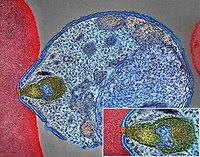
Photo from wikipedia
Background It was recommended that malaria rapid diagnostic tests (RDTs) should be available in all epidemiological situations. But evidence was limited on the implementation of RDTs and its effectiveness in… Click to show full abstract
Background It was recommended that malaria rapid diagnostic tests (RDTs) should be available in all epidemiological situations. But evidence was limited on the implementation of RDTs and its effectiveness in malaria elimination settings. This study examined the implementation of RDTs and how it affected the diagnosis of imported malaria patients in Jiangsu Province, China. Methods To scale up RDTs, this study developed an intervention package with four major elements covering the supply of RDT test, the training on RDTs, the monitoring and management of RDT use, and the advocacy of RDTs. By using a pretest-posttest control group design, we implemented the interventions in 4 cities in Jiangsu Province with the rest nine cities as controlled areas, from January 2017 to January 2018. Difference-in-Difference approach was used to evaluate the impact of the scale-up of RDTs on the identification of malaria cases. Three binary outcome measures were included to indicate delayed malaria diagnosis, malaria cases with confirmed malaria diagnosis at township-level institutions, and severe malaria cases, respectively. Linear probability regression was performed with time and group fixed effects and the interaction term between time and group. Results Intervention areas received sufficient RDT test supply, regular professional training programs, monthly tracking and management of RDT supply and use, and health education to targeted population. The implementation of interventions was associated with 10.8% ( P = 0.021) fewer patients with delayed diagnosis. But intervention areas did not see a higher likelihood of having confirmed diagnosis from township-level institutions (coefficient = -0.038, P = 0.185) or reduced severe malaria cases (coef. = 0.040, P = 0.592). Conclusions The comprehensive package of RDT implementation in this study is promising in scaling up RDT use and improving access to care among malaria patients, especially in malaria elimination settings.
Journal Title: Infectious Diseases of Poverty
Year Published: 2020
Link to full text (if available)
Share on Social Media: Sign Up to like & get
recommendations!